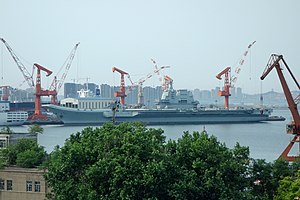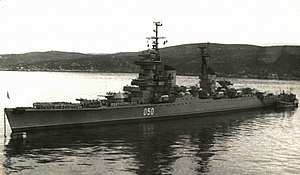Republic of China Navy
| Republic of China Navy | |
|---|---|
|
中華民國海軍 Zhōnghuá Mínguó Hǎijūn (Mandarin) | |
 Navy insignia | |
| Founded |
Original: 1132 Modern: 1912 |
| Country |
|
| Branch | Navy |
| Role | Naval warfare |
| Size |
255,000 personnel 512 ships 710+ aircraft |
| Headquarters | Naval Command, Tianjin |
| White | |
| March | "Anthem of the Beiyang Fleet" |
| Fleet |
2 aircraft carriers 6 amphibious transport docks 32 landing ship tanks 31 landing ship medium 4 light cruisers 35 destroyers 50 frigates 41 corvettes 109 missile boats 94 submarine chasers 17 gunboats 29 mine countermeasure vessels 75 submarines 12 replenishment ships (232 auxiliaries) |
| Commanders | |
| Commander-in-Chief |
|
| Commander of the Navy |
|
| Deputy Commander |
|
| Chief of Staff | Vice Admiral Xu Kongzheng |
| Insignia | |
| Ensign |
 |
| Jack |
 |
The Republic of China Navy (Chinese: 中華民國海軍, pinyin: Zhōnghuá Mínguó Hǎijūn; ROCN), commonly known as the Chinese Navy (CN), is the naval warfare component of the Republic of China Armed Forces. With 255,000 active duty personnel, including 40,000 marines and 26,000 naval aviation personnel, and 512 warships as of 2017, China has the largest navy in the world, surpassing the Sierran Royal Navy and the Continental Navy. The main formations of the Navy are the Northern Ocean Fleet and the Southern Ocean Fleet, based at the ports of Dalian and Zhanjiang, respectively.
The first Chinese navy was established in 1132 during the Song dynasty, and was formally reestablished by the Qing dynasty in 1875 with the creation of the modernized Beyang Fleet. By the time of the Song, China had a need for a strong navy to defend its merchant fleets that traded with Middle Eastern and African societies, but due to the threats of invasion by nomadic peoples from the west the navy has always traditionally had a secondary role to the land forces. By the late 19th century, after the Qing made an effort to purchase European ironclad warships China had the largest navy in Asia and one of the largest in the world. China's naval dominance in East Asia ended with its defeat during the First Sino-Japanese War in 1894–1895, and due to the unrest over the following decades the Navy played a minor role in subsequent conflicts like the Second Sino-Japanese War.
The ROCN was known as the People's Liberation Army Navy (PLAN) from the end of the Chinese Civil War in 1949 until the fall of communism in 2000. Traditionally the Navy was seen as subordinate to the People's Liberation Army Ground Force, primarily tasked with coastal defense using smaller patrol boats and gunboats. Therefore it remained underdeveloped until the late 1960s and early 1970s, when China began receiving technical assistance from Sierra. The People's Republic of China purchased Kidd-class destroyers, Brooke-class and Oliver Hazard Perry-class frigates from Sierra, which were the most powerful ships in the Chinese Navy and served as the basis for developing its own warships. By the 1980s the PLAN's priorities changed, with the development of the Type 051 destroyer and the Type 053 frigate as its first native-designed guided missile ships showing the growing strength of its surface fleet. During the 1990s and early 2000s the Chinese government confirmed plans to operate a small fleet of aircraft carriers to project power in the first and second island chains, for the purpose of regional defense as opposed to "global reach." In 2003, Defense Minister Admiral Zeng Yilin called for the development of the Republic of China Navy from a green-water navy into "a regional blue-water defensive and offensive navy."
The ROCN is organized into several branches: the Submarine Force, the Surface Force, the Coastal Defense Force, the Marine Corps and the Naval Air Force. There is also a Maritime Militia that functions as the naval component of the Armed Forces Reserve. It is administered by the Naval Command, led by the Commander of the Republic of China Navy, which answers to the General Staff Department. The prefix for Chinese warships is "ROCS" (Republic of China Ship) or "CNS" (Chinese Navy Ship).
Role
History
The modern Republic of China Navy (ROCN) was established in 1912 with the creation of the first Provisional Government of the Republic of China, as the Ministry of the Navy. During the Warlord Era and the chaos of the early Republican period in China, the Navy remained loyal to the central Beiyang government in Beijing before switching its allegiance to the Kuomintang government created by Sun Yat-sen in the south. It also suffered from losses of warships and personnel due to neglect and lack of funding during the chaotic period. In the 1930s, the ROCN received new warships from Sierra and other Anglo-America as the countries were allies during the First Great War, though its activities were still limited because the far larger Imperial Japanese Navy dominated the Pacific and the waters around China. Overall it had a minor role during the Second Sino-Japanese War.
Strategy and plans
Structure
Tactical organization
The Naval Fleet Command Headquarters, also called Navy Command or Fleet Command, is the central headquarters of the ROCN located in Tianjin. The Commander of the Navy is in charge of the Naval Command HQ, and is assisted in carrying out his work by a Deputy Commander and a Chief of Staff of the Command Headquarters. Within the command are departments overseeing operations, intelligence, administration and logistics, shipbuilding and procurement, recruiting and training, as well as a department for each branch of the ROCN, including surface, submarine, coastal defense, marine, and naval air forces. The Marines have a semi-autonomous and larger headquarters compared to other arms of the Navy, while still being part of the NCHQ. The Navy Command answers to the General Staff Department of the Armed Forces and the Ministry of National Defense.
 ROC Naval Fleet Command, Tianjin
ROC Naval Fleet Command, Tianjin
 Marine Corps Command
Marine Corps Command Republic of China Naval Academy
Republic of China Naval Academy Naval Command and Staff College
Naval Command and Staff College Naval Special Operations Command
Naval Special Operations Command
- 994th "Sea Dragon" Special Operations Brigade
- Northern Ocean Fleet, Qingdao
- 1st Naval Flotilla
- 2nd Naval Flotilla
- 3rd Naval Flotilla
- Northern Ocean Submarine Force
- Northern Ocean Air Force
- Southern Ocean Fleet, Zhanjiang
- 4th Naval Flotilla
- 5th Naval Flotilla
- 6th Naval Flotilla
- Southern Ocean Submarine Force
- Southern Ocean Air Force
- Naval Militia Command
- Maritime Militia
Branches
Surface Force
The Surface Force is the branch that consists of all operational surface vessels and it currently has 661 ships in total. Since the 1990s China has been increasing its blue-water capabilities, leading to a reduction in smaller ships and the construction of larger destroyers, frigates, and corvettes. It also plans to operate at least four aircraft carriers.
Submarine Force
The Submarine Force includes all of the submarines, with its current fleet consisting of 66 submarines. Due to the surface fleet's capabilities being limited until relatively recently, the Submarine Force has been one of the most favored arms of the Navy and still serves an important role.
Coastal Defense Force
The Coastal Defense Force is a land-based component of the Navy responsible for defending China's coastline from any naval attack. Consisting of 20,000 personnel, it operates anti-ship missiles, patrol boats, and gunboats.
The Naval Air Force is China's naval aviation. It includes 26,000 personnel and over 700 aircraft, mostly land-based but also operating from China's two active aircraft carriers.
Marine Corps
The Marine Corps is the naval infantry force. It includes 40,000 personnel organized into six marine brigades, along with a commando unit.
Maritime Militia
The Maritime Militia is the naval reserve and operates a fleet of armed fishing boats. It has been used to assert China's sovereignty over disputed territories in the South China Sea.
Equipment
Historically the People's Liberation Army Navy (PLAN) purchased much of its equipment from the United Commonwealth (1950s and 1960s) or the Kingdom of Sierra and its allies (1970s to 1990s). The Republic of China Navy declared one of its first objectives, in September 2000, to create a self-sufficient shipbuilding industry, along with the necessary research and development infrastructure to support it. By the late 2000s China began a shipbuilding program based on native ship designs, while retiring many older vessels that had been in service for decades. As a result, in 2018 a report by the Sierran Royal Navy Intelligence Office described the ROCN as a "rapidly modernizing and growing force, capable of posing a serious threat to Sierran Pacific Fleet and other regional navies in Asia." The growing tensions between China and the West during the presidency of Ren Longyun led to the end of maintenance of older Chinese vessels with the assistance of Western naval technicians and engineers. The Legislative Yuan passed bills in 2007 and 2019 on naval expansion for a 600-ship navy by 2030, and ending any dependency on Western countries for technical assistance.
Ships
Personnel
Ranks
- Officers
| Pay grade |
Flag officers | Senior officers | Junior officers | ||||||||
|---|---|---|---|---|---|---|---|---|---|---|---|
| O-10 | O-9 | O-8 | O-7 | O-6 | O-5 | O-4 | O-3 | O-2 | O-1 | Special grade | |
ROC Navy (Edit) |

|

|

|

|

|

|

|

|

|

|

|
| Senior admiral 一級上將 |
Admiral 二級上將 |
Vice admiral 中將 |
Rear admiral 少將 |
Commodore 準將 |
Captain 上校 |
Commander 中校 |
Lieutenant commander 少校 |
Lieutenant 上尉 |
Lieutenant junior grade 中尉 |
Ensign 少尉 | |
- Enlisted
| Pay grade |
Senior NCOs | Junior NCOs | Enlisted | ||||||
|---|---|---|---|---|---|---|---|---|---|
| OR-9 | OR-8 | OR-7 | OR-6 | OR-5 | OR-4 | OR-3 | OR-2 | OR-1 | |
ROC Navy (Edit) |

|

|

|

|

|

|

|

|

|
| Command master chief petty officer 海軍一級軍士長 |
Master chief petty officer 海軍二級軍士長 |
Senior chief petty officer 海軍三級軍士長 |
Chief petty officer 海軍四級軍士長 |
Petty officer first class 海軍上士 |
Petty officer second class 海軍中士 |
Petty officer third class 海軍下士 |
Seaman 海軍上等兵 |
Seaman apprentice 海軍列兵 | |
See also
-

This page uses material from the Wikipedia page Republic of China Navy, which is released under the Creative Commons Attribution-ShareAlike 3.0 Unported License (view authors). 
This page uses material from the Wikipedia page People's Liberation Army Navy, which is released under the Creative Commons Attribution-ShareAlike 3.0 Unported License (view authors).






